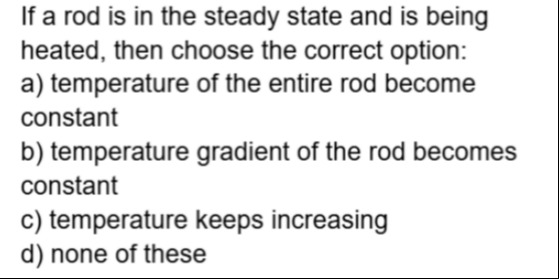Question
Question: If a rod is in the steady state and is being heated, then choose the correct option:...
If a rod is in the steady state and is being heated, then choose the correct option:

temperature of the entire rod become constant
temperature gradient of the rod becomes constant
temperature keeps increasing
none of these
temperature gradient of the rod becomes constant
Solution
In the context of heat transfer, a "steady state" means that the temperature at any given point within the rod does not change with time. This does not imply that the temperature is uniform throughout the rod.
-
Steady State Condition: For a rod in a steady state where heat is flowing through it, the rate of heat transfer (Q/t) through any cross-section of the rod must be constant. If it were not constant, heat would accumulate or deplete in certain sections, leading to a change in temperature over time, which contradicts the definition of a steady state.
-
Fourier's Law of Heat Conduction: The rate of heat transfer by conduction is given by:
tQ=−kAdxdT
where:
- Q/t is the rate of heat flow.
- k is the thermal conductivity of the rod material.
- A is the cross-sectional area of the rod.
- dT/dx is the temperature gradient (change in temperature per unit length).
-
Applying to Steady State:
- Since Q/t is constant in a steady state.
- For a uniform rod, k and A are constant.
- Therefore, to maintain a constant Q/t, the temperature gradient dxdT must also be constant. This implies that the temperature changes linearly along the length of the rod.
-
Analyzing the Options:
- a) temperature of the entire rod become constant: This is incorrect. If the temperature were constant throughout the rod, there would be no temperature gradient, and thus no heat flow. Steady state heating implies heat flow with stable temperatures at each point, not uniform temperature across the rod.
- b) temperature gradient of the rod becomes constant: This is correct. As explained above, for a uniform rod in steady state, the constant rate of heat flow necessitates a constant temperature gradient.
- c) temperature keeps increasing: This is incorrect. If the temperature keeps increasing, the system is not in a steady state; it is in a transient state. In steady state, temperatures at all points are constant with respect to time.
- d) none of these: This is incorrect because option (b) is correct.
